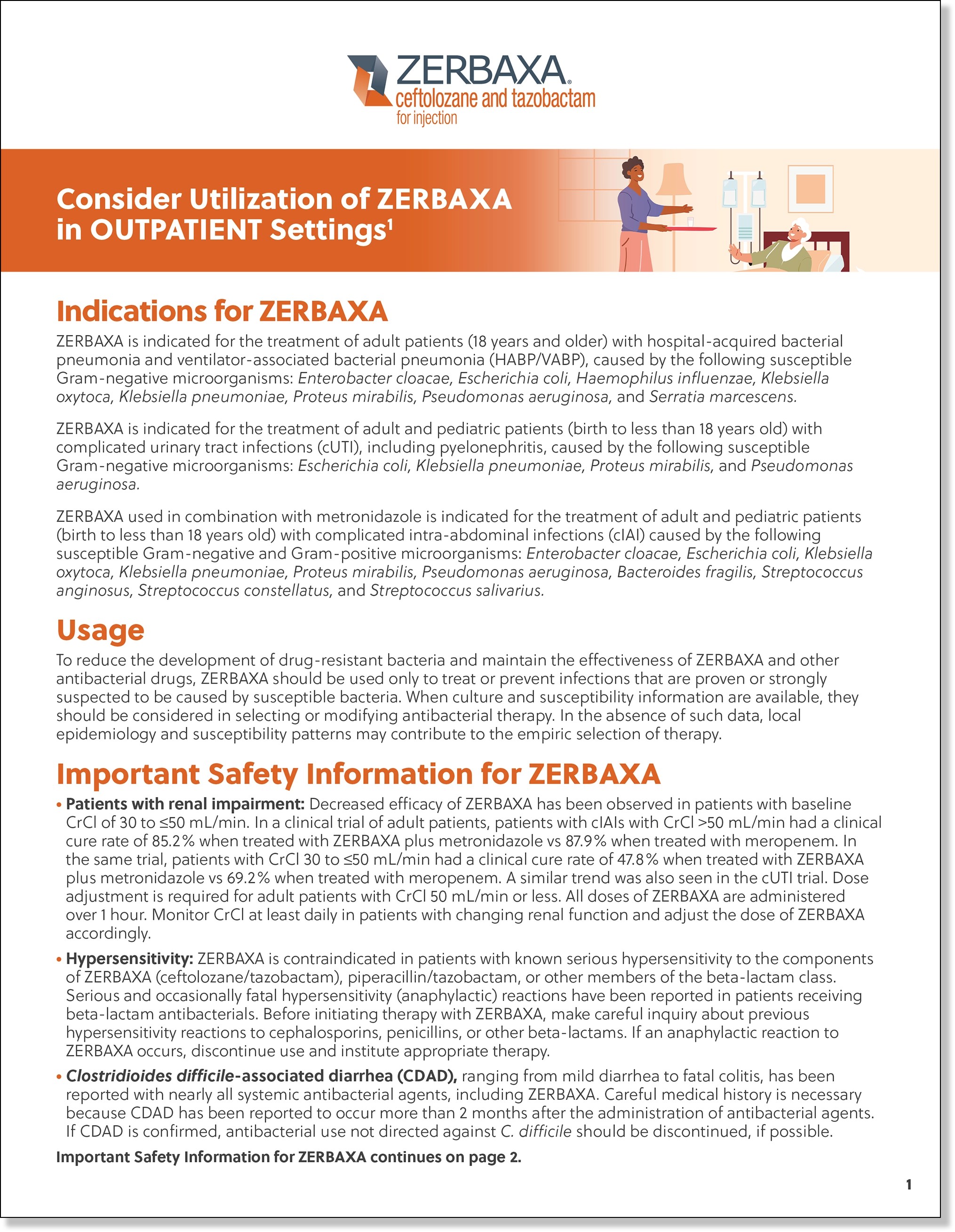Outpatient utilization of ZERBAXA® (ceftolozane and tazobactam)
Learn about:
Utilization of ZERBAXA in inpatient and outpatient health care settings1
Stability and dosing
Drug stability is an important consideration when selecting an antimicrobial for outpatient use2
Upon constitution with sterile water for injection or 0.9% sodium chloride injection, reconstituted solution of ZERBAXA may be held in the vial for 1 hour prior to transfer and dilution of the solution (with 0.9% of sodium chloride or 5% dextrose) in a suitable infusion bag.
Following dilution of the solution with 0.9% sodium chloride or 5% dextrose, ZERBAXA is stable for 24 hours when stored at room temperature or 7 days when stored under refrigeration at 2°C to 8°C (36°F to 46°F). Discard unused portion.
- Constituted ZERBAXA solution or diluted ZERBAXA infusion should not be frozen.
Dosing: ZERBAXA is infused over a 1-hour period
Dosage of ZERBAXA by infection in adult patients (18 years and older) with CrCIa >50 mL/min
- The duration of therapy should be guided by the severity and site of infection and the patient’s clinical and bacteriological progress.
Dosage of ZERBAXA in adult patients with renal impairment (CrCla ≤50 mL/min)
- The duration of therapy should be guided by the severity and site of infection and the patient’s clinical and bacteriological progress.
- For patients with changing renal function, monitor CrCl at least daily and adjust dosage of ZERBAXA accordingly.
Dosage of ZERBAXA by infection in pediatric patients (birth to less than 18 years of age) with eGFRc greater than 50 mL/min/1.73 m2
bUsed in conjunction with metronidazole.
cEstimated GFR using an age-appropriate equation for use in the pediatric population.
dPediatric patients weighing greater than 50 kg should not exceed a maximum dose of 1.5 g.
There is insufficient information to recommend a dosage regimen for pediatric patients with HABP/VABP.
Dosage adjustments in pediatric patients with cUTI or cIAI and with renal impairment
Dosage adjustment of ZERBAXA in pediatric patients (birth to less than 18 years of age) with eGFR of 50 mL/min/1.73 m2 or less has not been determined. ZERBAXA is not recommended in pediatric patients who have an eGFR 50 mL/min/1.73 m2 or less.
cIAI, complicated intra-abdominal infection; CrCl, creatinine clearance; cUTI, complicated urinary tract infection; eGFR, estimated glomerular filtration rate; ESRD, end-stage renal disease; HABP, hospital-acquired bacterial pneumonia; VABP, ventilator-associated bacterial pneumonia.
Outpatient information
Download the outpatient utilization and dosing information resource for ZERBAXA.

Questions About Ordering? Contact the Merck National Service Center 1-800-672-6372 (1-800-NSC-Merc).
References
- Data available on request from Merck Professional Services-DAP, WP1-27, PO Box 4, West Point, PA 19486-0004. Please specify information package US-ZER-01761.
- Norris AH, Shrestha NK, Allison GM, et al. 2018 Infectious Diseases Society of America clinical practice guideline for the management of outpatient parenteral antimicrobial therapy. Clin Infect Dis. 2019;68(1):e1-e35.doi:10.1093/cid/ciy745
